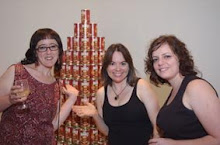Here's the text of the catalogue essay that accompanied the exhibition at the Bathurst Regional Art Gallery February 1 to March 30, 2008:
At some point in the mid-1970s, my parents hung wallpaper on one wall in the living room. It featured large, head-sized lairy green flowers. The repeated pattern was overwhelming, headache-inducing, if stared at for too long. We loved it. Then someone had a bright idea. Why not pick out the little circles at the end of each stamen in orange Hobbytex?
During the 1980s, lairy wallpaper – different colours, different patterns, just as overwhelming - followed me through a series of rented share-houses. In the 1990s, friends with their own mortgages attacked wallpaper with gusto, using steam and scrapers and passion to eliminate every last shred of the stuff.
And now, thirty years later, wallpaper is back. It’s big, it’s lairy, it’s all-consuming and rather disconcerting. It’s like waking up to find the world is copying something in my own dreams, because for the last little while, I have been on my own private wallpaper journey.
Slumped before the internet, the computer fan whirring quietly to my left, the gurgling sound of the goldfish tank to my right, I’ve been looking for that original green wallpaper. I google “70s wallpaper” or type it into the search window of eBay. There it is, in all its purple, brown, orange and green glory. But never the one particular pattern I’m looking for, the one we set off nicely with Hobbytex. I’ve forgotten precisely what it looked like, and there are no photographs of it, but I know I’ll recognise it when I see it. If only I could see it. So the hunt continues, the hours fly by.
For me, this exhibition is about loss and the tantalising, almost-but-not-quite recovery of lost memory through objects. It is about digging down through the layers of detritus of this culture and finding nuggets of gold.
Inevitably, given that we're talking about the Decade That Taste Forgot, it’s also about kitsch. And what better place to discuss kitsch than in the kitschen? One room in this exhibition is devoted to Denise and her Manwich sandwich. This room sets off conflicting responses. There’s an attraction to the simple values and retro style of Denise, a longing for a “return” to the world she represents, even if it’s a world nobody ever really inhabited. The heart reaches out to these things but the head – the educated, sophisticated head – slaps it down. You can have it, says the head, but only in a knowing framework. Only if you make it perfectly clear that you get the joke.
It was in the 1970s that the women’s art movement took off, a movement that asserted that the domestic realm was worthy of artistic interpretation and exploration. Karen Golland’s work takes domestic crafts – in their 1970s incarnations - as a starting point for a series of prints featuring the patterns of hand-crocheted doilies; fluffy wall cushions suggestive of the synthetic textured rugs of the time and plastic strips enhancing the humble pattern of striped bed sheets. These works are both a delight to look at and laced with layers of meaning about art, craft and women’s work.
In another room, we take you all the way back to the source. Here, you find unadorned, naked examples of the original crafts: an orange macrame owl, a string art lamp, an unfinished Hobbytex tablecloth. Among men and boys in particular, these crafts have been known to set off a mild horror, a desire to get away as quickly as possible.
Beyond questions of taste and discrimination, this room invites stories. Every one of these objects has a story, suggests a story. If you were there in the '70s, you'll have your own. If you weren't born yet, expect to hear a few on your way through. The video installation tells some of the stories of the pieces and lets others speak for themselves.
Sound artist Michelle Stockwell has created a layered soundscape for the exhibition, creating an immersive environment which echoes the creative processes involved in conceiving and creating this project. She has layered snippets of interviews with artists and craftspeople, phrases and sentences from Germaine Greer's Female Eunuch, the sizzling of an electric frypan, the spraying of hairspray, the clack of typewriter keys to create a sound landscape that evokes the almost-but-not quite, seen-out-of-the-corner-of-the-eye sensations of dreams and memories. It is this soundscape, loose, quiet, but all-pervasive, that holds the three distinct rooms of the exhibition together.
Tracy Sorensen
Sunday, August 31, 2008
Subscribe to:
Posts (Atom)

